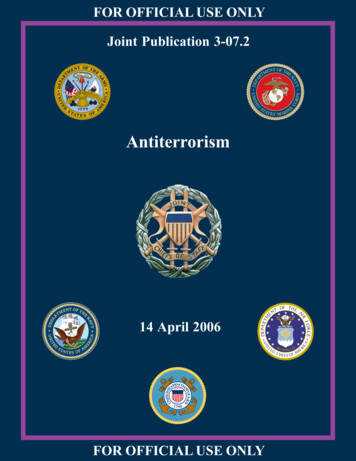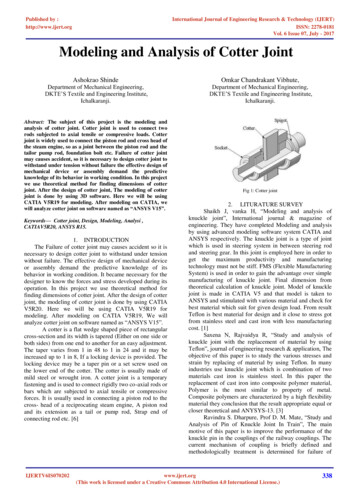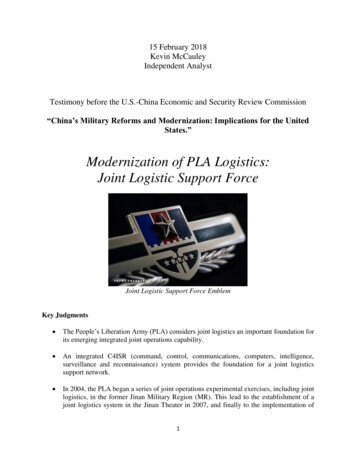
Transcription
FOR OFFICIAL USE ONLYJoint Publication 3-07.2Antiterrorism14 April 2006FOR OFFICIAL USE ONLY
FOR OFFICIAL USE ONLYPREFACE1.ScopeThis publication provides doctrine on how to organize, plan, train for, and conduct jointantiterrorism operations.2.PurposeThis publication has been prepared under the direction of the Chairman of the Joint Chiefsof Staff. It sets forth joint doctrine to govern the activities and performance of the Armed Forcesof the United States in operations and provides the doctrinal basis for interagency coordinationand for US military involvement in multinational operations. It provides military guidance forthe exercise of authority by combatant commanders and other joint force commanders (JFCs)and prescribes joint doctrine for operations and training. It provides military guidance for useby the Armed Forces in preparing their appropriate plans. It is not the intent of this publicationto restrict the authority of the JFC from organizing the force and executing the mission in amanner the JFC deems most appropriate to ensure unity of effort in the accomplishment of theoverall objective.3.Applicationa. Joint doctrine established in this publication applies to the commanders of combatantcommands, subunified commands, joint task forces, subordinate components of these commands,and the Services.b. The guidance in this publication is authoritative; as such, this doctrine will be followedexcept when, in the judgment of the commander, exceptional circumstances dictate otherwise.If conflicts arise between the contents of this publication and the contents of Service publications,this publication will take precedence unless the Chairman of the Joint Chiefs of Staff, normallyin coordination with the other members of the Joint Chiefs of Staff, has provided more currentand specific guidance. Commanders of forces operating as part of a multinational (alliance orcoalition) military command should follow multinational doctrine and procedures ratified bythe United States. For doctrine and procedures not ratified by the United States, commandersshould evaluate and follow the multinational command’s doctrine and procedures, whereapplicable and consistent with US law, regulations, and doctrine.For the Chairman of the Joint Chiefs of Staff:WALTER L. SHARPLieutenant General, USADirector, Joint StaffiFOR OFFICIAL USE ONLY
FOR OFFICIAL USE ONLYPrefaceIntentionally BlankiiJP 3-07.2FOR OFFICIAL USE ONLY
FOR OFFICIAL USE ONLYSUMMARY OF CHANGESREVISION OF JOINT PUBLICATION 3-07.2DATED 17 MARCH 1998 Provides a description of the overall operational context. Expands the discussion of protection, force protection, and antiterrorismrelationships. Covers Department of Defense policy for the antiterrorism program. Discusses the role of the Assistant Secretary of Defense for HomelandDefense. Covers the Department of Defense’s roles in homeland defense and supportto civil authorities. Updates the discussion of terrorist threats to include the general shift intactics and methodologies among international terrorists to produce masscasualties. Provides examples of terrorist asymmetric tactics, techniques, andprocedures. Adds extensive coverage of countersurveillance. Adds a discussion of limits of military support to civil authorities. Annunciates the “No Double Standard” policy. Revises the antiterrorism program elements to include risk management,planning, training and exercises, resource generation, and program reviews. Defines risk management as having four subelements: criticalityassessment, threat assessment, vulnerability assessment, and riskassessment. Greatly expands the concept of antiterrorism measures. Adds a discussion of design based threat. Covers barrier planning. Discusses range-to-effect charts and window upgrades.iiiFOR OFFICIAL USE ONLY
FOR OFFICIAL USE ONLYSummary of Changes Covers suicide bombers/high risk vehicle checkpoints. Adds community engagement to the antiterrorism program. Completely revises coverage of incident response and consequencemanagement. Adds considerations for incident response in the United States. Adds appendices on criticality assessment, threat assessment, and riskassessment. Adds appendices with sample antiterrorism plan format, antiterrorismchecklist, and sample barrier plan. Adds appendix on the force protection condition system. Adds appendices on threat information organization matrix, homelandsecurity advisory system, chemical, biological, radiological, and nucleardefense planning considerations, and joint antiterrorism programmanager’s guide. Redefines the terms “antiterrorism,” “force protection,” “force protectionconditions,” “terrorist,” “terrorist group,” and “terrorist threat level.” Provides definitions for the terms “chemical, biological, radiological, andnuclear defense,” “chemical, biological, radiological, nuclear, and high-yieldexplosive hazards,” “criticality assessment,” and “design basis threat.”ivJP 3-07.2FOR OFFICIAL USE ONLY
FOR OFFICIAL USE ONLYTABLE OF CONTENTSPAGEEXECUTIVE SUMMARY . ixCHAPTER IINTRODUCTION General Operational Context .Purpose.Protection, Force Protection, and Antiterrorism Relationships .Overview of Antiterrorism Program Elements .Overview of Department of Defense Role and Responsibility .I-1I-1I-2I-5I-6CHAPTER IITERRORIST THREAT General .Terrorist Tactics .Terrorist Groups.Terrorist Organizations.Terrorism Against the Homeland .Asymmetric Tactics, Techniques, and Procedures .II-1II-1II-4II-5II-8II-9CHAPTER IIIINTELLIGENCE, COUNTERINTELLIGENCE, THREAT ANALYSIS, ANDCOUNTERSURVEILLANCE Intelligence and Counterintelligence . III-1Threat Analysis . III-7Countersurveillance . III-9Threat Levels . III-12CHAPTER IVLEGAL CONSIDERATIONS General .Commander’s Authority.Limits of Military Support to Civil Authorities .Authority for Handling Terrorist Incidents .United States Coast Guard .IV-1IV-1IV-1IV-5IV-8vFOR OFFICIAL USE ONLY
FOR OFFICIAL USE ONLYTable of ContentsCHAPTER VANTITERRORISM PROGRAM: INSTALLATION, BASE, SHIP, UNIT,AND PORT Overview of Program Concept . V-1Antiterrorism Plan Development . V-5Combatant Commander’s Responsibility . V-6CHAPTER VIPREVENTIVE MEASURES AND CONSIDERATIONS Commander’s Responsibility to Manage Terrorism Risk . VI-1Antiterrorism Measures . VI-1Design Basis Threat . VI-14Barrier Planning. VI-15Range-to-Effect Charts . VI-19Window Upgrades . VI-20New Construction and Renovation . VI-23Joint Rear Areas . VI-25Suicide Bombers/High Risk Vehicle Checkpoints. VI-25Airfield-Specific Threats . VI-33Information Operations . VI-35Community Engagement . VI-36CHAPTER VIIINCIDENT RESPONSE AND CONSEQUENCEMANAGEMENT General . VII-1Incident Management Planning . VII-2Initial Response . VII-2Follow-On Response . VII-4Initial Response to a Chemical, Biological, Radiological, Nuclear, andHigh-Yield Explosives Attack . VII-6Special Considerations . VII-8Considerations in the United States . VII-11APPENDIXABCDEFCriticality Assessment . A-1Threat Assessment . B-1Vulnerability Assessment . C-1Risk Assessment . D-1Sample Antiterrorism Plan Format . E-1Antiterrorism Checklist . F-1viJP 3-07.2FOR OFFICIAL USE ONLY
FOR OFFICIAL USE ONLYTable of ContentsGHJKLMSample Barrier Plan. G-1Force Protection Condition System . H-1Jurisdictional Authority for Handling Terrorist Incidents . J-1Threat Information Organization Matrix . K-1Homeland Security Advisory System . L-1Chemical, Biological, Radiological, and Nuclear DefensePlanning Considerations . M-1N Joint Antiterrorism Program Manager’s Guide . N-1O References. O-1P Administrative Instructions . P-1GLOSSARYPart I Abbreviations and Acronyms . GL-1Part II Terms and Definitions . I-1D-1D-2G-1Combating Terrorism . I-2Antiterrorism and Counterterrorism . I-3The Protection Community . I-4Department of Defense’s Operational Descriptions of Homeland Securityand Mission Areas . I-16Categories of Terrorist Groups . II-4Structure Pyramid of a Typical Terrorist Organization . II-5Sources of Intelligence and Counterintelligence . III-2Information Requirements . III-8Request for Assistance . IV-2Department of Defense Threat Level and Force Protection Conditions . V-4Situation Estimate Checklist . VI-2Recommended Ditching Procedures . VI-4Traffic Control Point. VI-5Security Force Equipment . VI-6Principles of Riot Control . VI-13Barrier Planning Relationships . VI-16Typical Range-to-Effect Chart . VI-20Small Car Bomb Attack . VI-21Barrier Plan for Small Car Bomb Attack . VI-22Comparison of Various Glazing Options to Prevent Minor Cuts . VI-23Fragment Retention Film . VI-24Community Engagement . VI-36Special Considerations . VII-8Example Asset Risk Assessment Table. D-3Example of Risk Assessment . D-4Barrier Plan for Base X-Ray . G-2viiFOR OFFICIAL USE ONLY
FOR OFFICIAL USE ONLYTable of ContentsG-2J-1K-1L-1M-1Tab C- To Base X-Ray Barrier Plan . G-3Jurisdictional Authority for Handling Terrorist Incidents . J-1Installation Threat Information Organization Plan . K-2Comparison of Homeland Security Advisory System with Departmentof Defense Force Protection Conditions . L-2Chemical, Biological, Radiological, and Nuclear Defense PlanningConsiderations . M-1viiiJP 3-07.2FOR OFFICIAL USE ONLY
FOR OFFICIAL USE ONLYEXECUTIVE SUMMARYCOMMANDER’S OVERVIEW Provides an Introduction to Antiterrorism Covers the Terrorist Threat Discusses Intelligence, Counterintelligence, Threat Analysis, andCountersurveillance Covers Legal Considerations Describes the Antiterrorism Program Discusses Preventative Measures and Considerations Covers Incident Response and Consequence ManagementIntroductionCombating terrorismCombating terrorism involves actions including antiterrorism (AT)(defensive measures used to reduce the vulnerability to terroristacts), counterterrorism (offensive measures taken to prevent, deter,preempt and respond to terrorism), consequence management (CM)(preparation for and response to consequences of a terrorist incident),and intelligence support (collection or dissemination of terrorism relatedinformation), taken to oppose terrorism throughout the entire threatspectrum.Force protection (FP)should not be used as asynonymous term withantiterrorism (AT) orother supporting tasks.Force protection (FP) is an overarching concept and missionresponsibility inherent to command within all military operations.As discussed throughout this publication, AT, in contrast, is asub-element of combating terrorism.FP is a joint task.Joint force commanders conduct FP in similar fashion to movementand maneuver; intelligence, surveillance, and reconnaissance; employingfirepower; sustaining operations; operating in a chemical, biological,radiological or nuclear environment; and providing command andcontrol during the execution of campaigns, major operations, and tacticalengagements. FP actions are to be accomplished by the Services andby joint forces under joint command and control using joint doctrine.FP can be applied at multiple levels of command, from the strategictheater, through the operational, and to the tactical level.ixFOR OFFICIAL USE ONLY
FOR OFFICIAL USE ONLYExecutive SummaryThe Department ofDefense’s (DOD’s) ATprogram is one of severalprograms that fall underthe overarching FPconcept.The AT program is a collective, proactive effort focused on thedetection and prevention of terrorist attacks against Departmentof Defense (DOD) personnel, their families, facilities,installations, and infrastructure critical to mission accomplishmentas well as the preparations to defend against and planning for theresponse to the consequences of terrorist incidents. The minimumelements of an AT program are: risk management; planning; trainingand exercises; resource generation; and comprehensive program review.Terrorist TacticsThe general shift intactics and methodologiesamong internationalterrorists focuses onproducing masscasualties.Terrorists continue to adapt to conditions and develop more aggressiveand effective methods, often incorporating multiple simultaneous attacksand suicide bombings. Their targets may be just as likely economic(tourists, financial networks) or agricultural ones (livestock, crops) asembassies or military forces/facilities. Their goal is not just to winfavor for their causes, but to wage undeclared, unconventional war atwill. The more common tactics employed by terrorist groups areassassination, arson, bombing, hostage taking, kidnapping, hijackingor skyjacking, seizure, raids or attacks on facilities, sabotage, hoaxes,use of weapons of mass destruction, and environmental destruction.Threat AnalysisTerrorism threat analysisis a continual process ofcompiling and examiningall available informationconcerning potentialterrorist activities byterrorist groups that couldtarget the DODcomponents, elements,and personnel.A threat analysis shall review the factors of a terrorist group’soperational capability, intentions, and activity as well as the operatingenvironment within which friendly forces operate. Threat analysis isan essential step in identifying and describing the threat posed byspecific terrorist group(s) and/or individuals in a terrorism threatassessment. A vulnerability assessment is an evaluation to determinethe vulnerability to a terrorist attack against an installation, unit, exercise,port, ship, residence, facility, or other site. In accomplishing thisassessment, it is important to consider the design basis threat todetermine the facility’s design and structural requirements. The threatassessment and vulnerability assessment are then utilized with thecriticality assessment to provide the basis for risk managementdecisions. Commanders must determine which assets require the mostprotection and where future expenditures are required to minimizerisk of attack or lessen the severity of the outcome of an attack.xJP 3-07.2FOR OFFICIAL USE ONLY
FOR OFFICIAL USE ONLYExecutive SummaryIntelligence and CounterintelligenceIntelligence andcounterintelligence arecritical in thedevelopment of an ATprogram.Strategic, well-planned, proactive, systematic, all-source intelligenceand counterintelligence (CI) programs are essential. The role ofintelligence and CI is to identify, assess, deter, disrupt, and defeat thethreat, provide advance warning, and disseminate critical information/intelligence in a usable form for the commander. All command personnelmay potentially contribute to information collection and analyticalefforts. Effective intelligence and CI support requires effort to executethe intelligence process and to conduct effective operations andinvestigations against the threat. The entire process is important inproviding decision makers with information and timely warnings uponwhich to recommend FP actions.Community EngagementEffective AT efforts extendbeyond the peerimeter.Commanders increase their capability to refine the local threat pictureand shape their operating environment by appropriate coordinationand interaction with local area residents. Whether inside the UnitedStates or at an expeditionary location, effective communication anddeveloped rapport among area leaders, nongovernmental organizations,businesses, residents, and military leaders support the defense-in-depthconcept and ensure the first layer of defense extends beyond the baseperimeter. Local language and cultural training for appropriatepersonnel also contribute to rapport development.Legal ConsiderationsCommander’s authority.A commander’s responsibility and authority to enforce securitymeasures and to protect persons and property are critical during anylevel of conflict. Commanders should consult with their legal advisorsoften when establishing their AT programs. Legal personnel should bemembers of all installation or unitAT cells, boards, and working groups.Constraints and restraintson military support tocivil authorities.DOD is the lead, supported by other agencies, in defending againsttraditional external threats/aggression against the US homeland.However, against internal, asymmetric, or nontraditional threats (e.g.,terrorism), DOD may be in support of the Department of HomelandSecurity or another lead or primary agency. When providing supportto civil authorities, DOD will do so as directed by the President or theSecretary of Defense and consistent with laws, Presidential directives,executive orders, and DOD policies and directives. The followinggeneral principles apply to such support:xiFOR OFFICIAL USE ONLY
FOR OFFICIAL USE ONLYExecutive SummaryExcept in the case of immediate response authority, DOD resourcesare provided only when response or recovery requirements are beyondthe capabilities of local, state, and Federal civil authorities, and whenthey are requested by a lead or primary agency and approved by theSecretary of Defense.In certain circumstances, imminently serious conditions resultingfrom either civil emergencies or attacks may require immediateresponse by military commanders. Responses to requests fromcivil authorities prior to receiving authority from the President or chainof command are made when immediate support is critical to savelives, prevent human suffering, or mitigate great propertydamage.Antiterrorism ProgramThe AT program stressesdeterrence of terroristincidents throughpreventive measurescommon to all combatantcommands and Services.In order to be successful, an AT program must be implemented in amethodical, coordinated manner. It cannot be stressed enough thatthe AT program is the ultimate responsibility of the commander or, inthe case of a DOD agency, the civilian equivalent, who has the authorityand responsibility to alter or add to the AT program as deemednecessary to accommodate the local situation. The minimum ATprogram elements include risk management, planning, training andexercises, resource generation, and program reviews. Plans for CMand incident response are important adjuncts to an effective ATprogram.Risk management is the process of systematically identifying, assessing,and controlling risks arising from operational factors and makingdecisions that balance risk costs with mission benefits. The commandermust decide how best to employ given resources and AT measures todeter, mitigate, and prepare for a terrorist incident while continuing themission. Risk management has four key subelements: criticalityassessment; threat assessment; and vulnerability assessment.The criticality assessment provides the commander with a prioritizedlist of assets based on the necessity for mission completion. Theterrorism threat assessment is the tool that commanders use todetermine the capability, intentions, and activity of terrorist organizations.The vulnerability assessment is the determination of susceptibility toattack by the broad range of terrorist threats. The risk assessmentcombines the criticality, threat, vulnerability, and risk assessments.xiiJP 3-07.2FOR OFFICIAL USE ONLY
FOR OFFICIAL USE ONLYExecutive SummaryPreventive Measures and ConsiderationsCommander’sresponsibility to manageterrorism risk.Although the risk of terrorist aggression against US and multinationalresources cannot be totally eliminated, it can be reduced and managedthrough deliberate and effective risk management. Command planningand execution should include actions to implementAT measures whichare consistent with fundamental risk management principles. Throughthe application of the basic risk management principles of identification,assessment, risk avoidance, loss prevention, loss reduction, andprocess evaluation/reapplication, most FP requirements can be met.Preventive and protective security measures should be taken by militaryunits and individual Service members to protect themselves and theirability to accomplish their mission during mobilization, deployment,employment, sustainment, and redeployment operations. Additionally,rest and recuperation (R&R) facilities and other facilities not located ina traditional military installation also require close consideration. Thesefacilities are frequently vulnerable due to their location and generallyeasy access. Service personnel are at risk of lowering their guardwhile using these R&R facilities. The installation, ship, unit, or port ATplan provides the mechanism to ensure readiness against terroristattacks while the unit performs its tactical mission during deployments.Incident Response and Consequence ManagementIncident management is asequence of command,staff, and first responderactions to respond to aterrorist incident or otherunique event and restoreAT capability.The primary objective of incident response management is to mitigatethe effects and number of casualties resulting from a terrorist attack.Commanders develop response measures to save lives, preserve healthand safety, secure and eliminate the hazard, protect property, preventfurther damage to the installation, and maintain public confidence inthe installation’s ability to respond to a terrorist incident.CM is the preparedness and response to mitigate the consequencesof an incident resulting from the use of chemical, biological, radiological,nuclear, and high-yield explosives (CBRNE) agents. It includes massalerting or notification capabilities, disaster planning, public health,medical surveillance and other preparatory efforts.A commander’s responsibility and authority to enforce securitymeasures and to protect persons and property is of utmost importanceduring any level of conflict. As such, it is incumbent upon the commanderto plan for, and be capable of reacting to, a terrorist attack. Attacksemploying CBRNE weapons may produce massive casualties orwidespread destruction, which can quickly overwhelm organicresources.xiiiFOR OFFICIAL USE ONLY
FOR OFFICIAL USE ONLYExecutive SummaryCONCLUSIONThis publication provides doctrine on how to organize, plan, train for,and conduct joint antiterrorism operations and interagency ATcoordination.xivJP 3-07.2FOR OFFICIAL USE ONLY
FOR OFFICIAL USE ONLYCHAPTER IINTRODUCTION“There is another type of warfare — new in its intensity, ancient in its origin — warby guerrillas, subversives, insurgents, assassins; war by ambush instead of bycombat, by infiltration instead of aggression, seeking victory by eroding andexhausting the enemy instead of engaging him . . . It preys on unrest . . . “John F. KennedyAddress to the Graduating Class,US Naval Academy, 6 June 19621.General Operational ContextAntiterrorism (AT) is a defensive component of combating terrorism (CbT). Defensiveelements of CbT are part of force protection (FP).a. The terrorism threat: Although there is no universal definition for terrorism, theDepartment of Defense (DOD) defines it as the calculated use of unlawful violence or threat ofunlawful violence to inculcate fear; intended to coerce or to intimidate governments or societiesin the pursuit of goals that are generally political, religious, or ideological. Terrorists operatingworldwide pose grave dangers to the Armed Forces of the United States, and the assurance thatour forces can accomplish their missions.b. Specific policy, directive guidance, standards, and proced
Revises the antiterrorism program elements to include risk management, planning, training and exercises, resource generation, and program reviews. Defines risk management as having four subelements: criticality assessment, threat assessment, vulnerability assessment, and risk assessment. Greatly expands the concept of antiterrorism measures.











